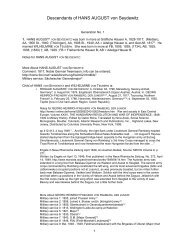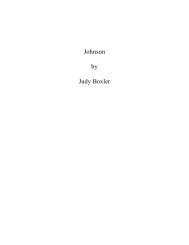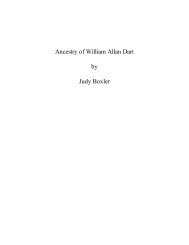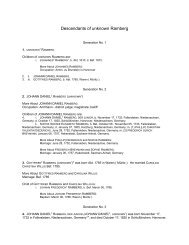<strong>Ancestry</strong> <strong>of</strong> <strong>Ethel</strong> B. <strong>Miles</strong> Descendants <strong>of</strong> WILLIAM Sabin Generation No. 1 1. WILLIAM 1 SABIN was born Bef. October 11, 1609 in Tichfield, Hampshire, England 1 , and died in Rehoboth, Bristol, Mass, USA. He married (1) MARY WRIGHT 2 , daughter <strong>of</strong> RICHARD WRIGHT. She was born 1618 in England, and died September 1660 in Rehoboth, Bristol, Mass, USA. He married (2) MARTHA ALLEN December 22, 1663 in Rehoboth, Bristol, Mass, USA 3,4 . More About WILLIAM SABIN: Burial: February 09, 1686/87, Rehoboth, Bristol, Mass, USA 5 Christening: October 11, 1609, St. Peter's Parish, Titchfield, Hampshire, England Occupation: Miller Probate: July 17, 1687 Will: June 14, 1685, Names "oldest son Samuel" and other sons Joseph, Benjamin, James, John, Hezekiah, Noah; daughters Experience, Abigail, Hannah Elizabeth, Patience, Mehitabell, Mary, Sarah, Margarett Children <strong>of</strong> WILLIAM SABIN and MARY WRIGHT are: 2. i. SAMUEL 2 SABIN, b. Abt. 1640, England; d. September 23, 1699, Rehoboth, Bristol, Mass, USA. ii. ELIZABETH SABIN, b. 1642, England; m. ROBERT MILLARD, December 24, 1663, Rehoboth, Bristol, Mass, USA. iii. JOSEPH SABIN, b. June 24, 1645, Rehoboth, Bristol, Mass, USA. iv. BENJAMIN SABIN, b. July 03, 1646, Rehoboth, Bristol, Mass, USA. v. NEHEMIAH SABIN, b. May 28, 1647, Rehoboth, Bristol, Mass, USA; d. June 1676, Rehoboth, Bristol, Mass, USA: slain and buried; m. ELIZABETH FULLER, August 01, 1672, Rehoboth, Bristol, Mass, USA. More About NEHEMIAH SABIN: Burial: June 1676, Rehoboth, Bristol, Mass, USA vi. EXPERIENCE SABIN, b. August 08, 1648, Rehoboth, Bristol, Mass, USA; m. SAMUELL BALLINS, August 20, 1672, Rehoboth, Bristol, Mass, USA. vii. MARY SABIN, b. July 23, 1652, Rehoboth, Bristol, Mass, USA; m. NATHANIEL ALLEN, April 1674. viii. ABIGAIL SABIN, b. November 08, 1653, Rehoboth, Bristol, Mass, USA; d. May 1721; m. JOSEPH BULLIN. ix. HANNAH SABIN, b. December 22, 1654, Rehoboth, Bristol, Mass, USA; m. JOSEPH ALLEN, November 10, 1673, Rehoboth, Bristol, Mass, USA. x. PATIENCE SABIN, b. February 28, 1655/56, Rehoboth, Bristol, Mass, USA. xi. JEREMIAH SABIN, b. March 24, 1657/58. xii. SARAH SABIN, b. September 27, 1660, Rehoboth, Bristol, Mass, USA. Children <strong>of</strong> WILLIAM SABIN and MARTHA ALLEN are: xiii. JAMES 2 SABIN, b. January 01, 1664/65, Rehoboth, Bristol, Mass, USA. xiv. JOHN SABIN, b. October 27, 1666, Rehoboth, Bristol, Mass, USA. xv. HEZEKIAH SABIN, b. April 03, 1669, Rehoboth, Bristol, Mass, USA. More About HEZEKIAH SABIN: Burial: January 09, 1688/89, Rehoboth, Bristol, Mass, USA xvi. NOAH SABIN, b. March 04, 1671/72, Rehoboth, Bristol, Mass, USA; d. January 19, 1690/91, Anticosta. More About NOAH SABIN: Military service: Town soldier; died at Anticosta 6 xvii. MEHITTABELL SABIN, b. May 16, 1673, Rehoboth, Bristol, Mass, USA; m. JOSEPH BUCKLAND, JR, Register Report <strong>of</strong> WILLIAM Sabin: 269
<strong>Ancestry</strong> <strong>of</strong> <strong>Ethel</strong> B. <strong>Miles</strong> xviii. xix. xx. June 30, 1691, Rehoboth, Bristol, Mass, USA. MARY SABIN, b. September 08, 1675, Rehoboth, Bristol, Mass, USA; m. NATHANIEL COOPER, December 08, 1696, Rehoboth, Bristol, Mass, USA. SARAH SABIN, b. February 16, 1676/77, Rehoboth, Bristol, Mass, USA. MARGARET SABIN, b. April 30, 1680, Rehoboth, Bristol, Mass, USA; d. July 10, 1697, Rehoboth, Bristol, Mass, USA. Generation No. 2 2. SAMUEL 2 SABIN (WILLIAM 1 ) was born Abt. 1640 in England, and died September 23, 1699 in Rehoboth, Bristol, Mass, USA 7,8 . He married MARY BILLINGTON 9 January 20, 1663/64 in Rehoboth, Bristol, Mass, USA 10,11 , daughter <strong>of</strong> FRANCIS BILLINGTON and CHRISTIAN PENN. She was born Abt. 1640 in Plymouth, Plymouth, Mass, USA. Notes for SAMUEL SABIN: http://www.mcc.gouv.qc.ca/pamu/champs/archeo/epaphips/wreck02.htm Phips' Expeditions against New France In the spring <strong>of</strong> 1689, war broke out in Europe between France and the League <strong>of</strong> Augsburg, a coalition <strong>of</strong> countries led by England. France wanted to launch a full-scale attack on the British colonies in America, particularly New York. For this purpose, the French decided to reinstate the Count <strong>of</strong> Frontenac as Governor General, despite the fact that he was 67 years old at the time. In 1690, Frontenac sent his troops to New England, where they attacked and destroyed a number <strong>of</strong> villages, killing their inhabitants or taking them prisoner. Frightened and horrified by these events, the residents <strong>of</strong> Boston developed a bitter hatred for their neighbours to the north and called for the destruction <strong>of</strong> Québec. New Englanders as a whole joined forces against New France. Phips was appointed commander <strong>of</strong> a squadron and immediately led his troops against Acadia. He arrived at Port Royal on May 22, 1690 and easily captured the post, then returned to Boston on June 9 with an impressive booty. On August 19 <strong>of</strong> the same year, Phips set sail for Québec with a fleet <strong>of</strong> about 30 ships, including 4 large vessels and over 2,000 men. After several delays, Phips finally reached Québec City on October 16. When he ordered Frontenac to surrender, the latter entrusted Phips' messenger with the now famous reply: "I will answer your general through the muzzles <strong>of</strong> my cannon and muskets." [Translation] Phips attacked Québec on October 18, but was driven back. He had to resign himself to returning to Boston a few days later. Phips' squadron encountered several storms on the return voyage. Although his own vessel reached its destination in December and others arrived in February, a number <strong>of</strong> ships were wrecked. Four never returned. Medal Commemorating the Victory <strong>of</strong> the French Frontenac's victory gave rise to lavish celebrations in New France as well as in France, where it was commemorated by a medal. One side <strong>of</strong> the medal shows Louis XIV in pr<strong>of</strong>ile and bears the inscription "Ludovicus magnus rex christianus" ["Louis, the great Christian king"]. An allegorical figure trampling the British flag is shown on the other side. To the left <strong>of</strong> the figure is a beaver, and to the right, another symbolic figure leaning on an urn, representing the St. Lawrence River. The inscription "Francia in novo orbe victorix" ["France, victorious in the New World"] may be read in the space below and, at the bottom, "Kebeca Liberata MDCXC" ["Québec, liberated in 1690"]. This medal was struck again in 1967 and presented to the people <strong>of</strong> Québec by General Charles de Gaulle, President <strong>of</strong> the French Republic, during his memorable visit to Expo 67, the Montréal world's fair. Register Report <strong>of</strong> WILLIAM Sabin: 270
- Page 1 and 2:
Ancestry of Ethel B. Miles by Judy
- Page 3 and 4:
Register Report of RALPH Prescott..
- Page 5 and 6:
Ancestry of Ethel B. Miles v. SARAH
- Page 7 and 8:
Ancestry of Ethel B. Miles 6. JOSEP
- Page 9 and 10:
Ancestry of Ethel B. Miles 1850 Cen
- Page 11 and 12:
Ancestry of Ethel B. Miles 73. F. K
- Page 13 and 14:
Ancestry of Ethel B. Miles 12
- Page 15 and 16:
Ancestry of Ethel B. Miles widdower
- Page 17 and 18:
Ancestry of Ethel B. Miles Children
- Page 19 and 20:
Ancestry of Ethel B. Miles 35. http
- Page 21 and 22:
Ancestry of Ethel B. Miles iii. BAS
- Page 23 and 24:
Ancestry of Ethel B. Miles 22
- Page 25 and 26:
Ancestry of Ethel B. Miles Mayflowe
- Page 27 and 28:
Ancestry of Ethel B. Miles More Abo
- Page 29 and 30:
Ancestry of Ethel B. Miles 28
- Page 31 and 32:
Ancestry of Ethel B. Miles viii. EL
- Page 33 and 34:
Ancestry of Ethel B. Miles £448. 3
- Page 35 and 36:
Ancestry of Ethel B. Miles birth].
- Page 37 and 38:
Ancestry of Ethel B. Miles Winslow
- Page 39 and 40:
Ancestry of Ethel B. Miles JOHN HIC
- Page 41 and 42:
Ancestry of Ethel B. Miles 40
- Page 43 and 44:
Ancestry of Ethel B. Miles 42
- Page 45 and 46:
Ancestry of Ethel B. Miles Baptism:
- Page 47 and 48:
Ancestry of Ethel B. Miles More Abo
- Page 49 and 50:
Ancestry of Ethel B. Miles +3 M ii.
- Page 51 and 52:
Ancestry of Ethel B. Miles 9. SARAH
- Page 53 and 54:
Ancestry of Ethel B. Miles Intestat
- Page 55 and 56:
61 23 348 359 Mary Clark 6 F -- --
- Page 57 and 58:
Ancestry of Ethel B. Miles in NY, U
- Page 59 and 60:
Ancestry of Ethel B. Miles More Abo
- Page 61 and 62:
Ancestry of Ethel B. Miles 38. Cyri
- Page 63 and 64:
Ancestry of Ethel B. Miles 115. 186
- Page 65 and 66:
Ancestry of Ethel B. Miles Descenda
- Page 67 and 68:
Ancestry of Ethel B. Miles 4. MARTH
- Page 69 and 70:
Ancestry of Ethel B. Miles 68
- Page 71 and 72:
Ancestry of Ethel B. Miles was; but
- Page 73 and 74:
Ancestry of Ethel B. Miles ------ S
- Page 75 and 76:
Ancestry of Ethel B. Miles Generati
- Page 77 and 78:
Ancestry of Ethel B. Miles 67. Dale
- Page 79 and 80:
Ancestry of Ethel B. Miles Children
- Page 81 and 82:
Ancestry of Ethel B. Miles 28. F. K
- Page 83 and 84:
Ancestry of Ethel B. Miles 4. EXPER
- Page 85 and 86:
Ancestry of Ethel B. Miles 84
- Page 87 and 88:
Ancestry of Ethel B. Miles Baptism:
- Page 89 and 90:
Ancestry of Ethel B. Miles 88
- Page 91 and 92:
Ancestry of Ethel B. Miles Endnotes
- Page 93 and 94:
Ancestry of Ethel B. Miles In the n
- Page 95 and 96:
Ancestry of Ethel B. Miles 1725, Du
- Page 97 and 98:
Ancestry of Ethel B. Miles Generati
- Page 99 and 100:
Ancestry of Ethel B. Miles 98
- Page 101 and 102:
Ancestry of Ethel B. Miles Child of
- Page 103 and 104:
Ancestry of Ethel B. Miles 71. Obit
- Page 105 and 106:
Ancestry of Ethel B. Miles iv. OBID
- Page 107 and 108:
Ancestry of Ethel B. Miles 106
- Page 109 and 110:
Ancestry of Ethel B. Miles 108
- Page 111 and 112:
Ancestry of Ethel B. Miles Generati
- Page 113 and 114:
Ancestry of Ethel B. Miles Mass, US
- Page 115 and 116:
Ancestry of Ethel B. Miles Children
- Page 117 and 118:
Ancestry of Ethel B. Miles 116
- Page 119 and 120:
Ancestry of Ethel B. Miles Occupati
- Page 121 and 122:
Ancestry of Ethel B. Miles 120
- Page 123 and 124:
Ancestry of Ethel B. Miles 122
- Page 125 and 126:
Ancestry of Ethel B. Miles Endnotes
- Page 127 and 128:
Ancestry of Ethel B. Miles More Abo
- Page 129 and 130:
Ancestry of Ethel B. Miles v. NATHA
- Page 131 and 132:
Ancestry of Ethel B. Miles iv. MARY
- Page 133 and 134:
Ancestry of Ethel B. Miles 132
- Page 135 and 136:
Residence: Boston, Mass, USA iii. A
- Page 137 and 138:
Ancestry of Ethel B. Miles 3. JOHN
- Page 139 and 140:
Ancestry of Ethel B. Miles children
- Page 141 and 142:
Ancestry of Ethel B. Miles Generati
- Page 143 and 144:
Ancestry of Ethel B. Miles Endnotes
- Page 145 and 146:
Ancestry of Ethel B. Miles 144
- Page 147 and 148:
More About JONATHAN PRESCOTT, DR.:
- Page 149 and 150:
Ancestry of Ethel B. Miles 148
- Page 151 and 152:
Ancestry of Ethel B. Miles Military
- Page 153 and 154:
Ancestry of Ethel B. Miles vii. HAN
- Page 155 and 156:
Ancestry of Ethel B. Miles 41. Jona
- Page 157 and 158:
Ancestry of Ethel B. Miles More Abo
- Page 159 and 160:
Ancestry of Ethel B. Miles 27. Jame
- Page 161 and 162:
Ancestry of Ethel B. Miles USA; d.
- Page 163 and 164:
Ancestry of Ethel B. Miles iv. SILE
- Page 165 and 166:
Ancestry of Ethel B. Miles 1620; d.
- Page 167 and 168:
Ancestry of Ethel B. Miles Endnotes
- Page 169 and 170:
Ancestry of Ethel B. Miles More Abo
- Page 171 and 172:
Ancestry of Ethel B. Miles 170
- Page 173 and 174:
Ancestry of Ethel B. Miles married
- Page 175 and 176:
Ancestry of Ethel B. Miles 174
- Page 177 and 178:
Ancestry of Ethel B. Miles married
- Page 179 and 180:
Ancestry of Ethel B. Miles 178
- Page 181 and 182:
Ancestry of Ethel B. Miles Will: Ap
- Page 183 and 184:
Ancestry of Ethel B. Miles More Abo
- Page 185 and 186:
Ancestry of Ethel B. Miles Children
- Page 187 and 188:
Ancestry of Ethel B. Miles Mr. Esta
- Page 189 and 190:
Ancestry of Ethel B. Miles 188
- Page 191 and 192:
Ancestry of Ethel B. Miles 3. JOHN
- Page 193 and 194:
Ancestry of Ethel B. Miles viii. OL
- Page 195 and 196:
Ancestry of Ethel B. Miles was born
- Page 197 and 198:
Ancestry of Ethel B. Miles Martha,
- Page 199 and 200:
Ancestry of Ethel B. Miles 162. 187
- Page 201 and 202:
Ancestry of Ethel B. Miles Residenc
- Page 203 and 204:
Ancestry of Ethel B. Miles 51. Vita
- Page 205 and 206:
Ancestry of Ethel B. Miles More Abo
- Page 207 and 208:
Ancestry of Ethel B. Miles 26 M ii.
- Page 209 and 210:
Ancestry of Ethel B. Miles 208
- Page 211 and 212:
Ancestry of Ethel B. Miles Baptism:
- Page 213 and 214:
Ancestry of Ethel B. Miles 212
- Page 215 and 216:
Ancestry of Ethel B. Miles vi. EBEN
- Page 217 and 218:
Ancestry of Ethel B. Miles SR. June
- Page 219 and 220: Ancestry of Ethel B. Miles 39. Vita
- Page 221 and 222: Ancestry of Ethel B. Miles vii. EBE
- Page 223 and 224: Ancestry of Ethel B. Miles 222
- Page 225 and 226: Ancestry of Ethel B. Miles vi. WILL
- Page 227 and 228: Ancestry of Ethel B. Miles 226
- Page 229 and 230: Ancestry of Ethel B. Miles v. NOAH
- Page 231 and 232: Ancestry of Ethel B. Miles 14, 1672
- Page 233 and 234: Ancestry of Ethel B. Miles Children
- Page 235 and 236: Ancestry of Ethel B. Miles More Abo
- Page 237 and 238: Ancestry of Ethel B. Miles 1719 in
- Page 239 and 240: Ancestry of Ethel B. Miles 238
- Page 241 and 242: Ancestry of Ethel B. Miles Christen
- Page 243 and 244: Ancestry of Ethel B. Miles 242
- Page 245 and 246: Ancestry of Ethel B. Miles Dedham,
- Page 247 and 248: Ancestry of Ethel B. Miles ii. MART
- Page 249 and 250: Ancestry of Ethel B. Miles 70. Vita
- Page 251 and 252: Ancestry of Ethel B. Miles 250
- Page 253 and 254: Ancestry of Ethel B. Miles 7. Vital
- Page 255 and 256: Ancestry of Ethel B. Miles Burial:
- Page 257 and 258: Ancestry of Ethel B. Miles 256
- Page 259 and 260: vii. HAMPTON RICH, b. 1815; d. 1900
- Page 261 and 262: Ancestry of Ethel B. Miles 6. CORNE
- Page 263 and 264: 106. Bible Records, [source of date
- Page 265 and 266: Ancestry of Ethel B. Miles KNIGHT 4
- Page 267 and 268: Ancestry of Ethel B. Miles 10. Wm.
- Page 269: Ancestry of Ethel B. Miles 268
- Page 273 and 274: Ancestry of Ethel B. Miles marriage
- Page 275 and 276: Ancestry of Ethel B. Miles 4. ii. M
- Page 277 and 278: Ancestry of Ethel B. Miles iv. PATI
- Page 279 and 280: Ancestry of Ethel B. Miles vi. vii.
- Page 281 and 282: Ancestry of Ethel B. Miles w. New S
- Page 283 and 284: Ancestry of Ethel B. Miles 282
- Page 285 and 286: Ancestry of Ethel B. Miles vii. vii
- Page 287 and 288: Ancestry of Ethel B. Miles 286
- Page 289 and 290: Ancestry of Ethel B. Miles vi. MARY
- Page 291 and 292: Ancestry of Ethel B. Miles 290
- Page 293 and 294: Ancestry of Ethel B. Miles and ELIZ
- Page 295 and 296: Ancestry of Ethel B. Miles 294
- Page 297 and 298: Ancestry of Ethel B. Miles 3. SARAH
- Page 299 and 300: Ancestry of Ethel B. Miles 30. Vita
- Page 301 and 302: Ancestry of Ethel B. Miles Christen
- Page 303 and 304: Ancestry of Ethel B. Miles Connecti
- Page 305 and 306: Ancestry of Ethel B. Miles vi.Rache
- Page 307 and 308: Ancestry of Ethel B. Miles 306
- Page 309 and 310: Ancestry of Ethel B. Miles 9. Vital
- Page 311 and 312: Plymouth, Plymouth, Mass, USA. Ance
- Page 313 and 314: Ancestry of Ethel B. Miles 312
- Page 315 and 316: Ancestry of Ethel B. Miles vi. HANN
- Page 317 and 318: Ancestry of Ethel B. Miles 316
- Page 319 and 320: Ancestry of Ethel B. Miles Henry: 3
- Page 321 and 322:
Ancestry of Ethel B. Miles Joseph:
- Page 323 and 324:
Ancestry of Ethel B. Miles Josiah:
- Page 325 and 326:
Ancestry of Ethel B. Miles Lydia: 2
- Page 327 and 328:
Ancestry of Ethel B. Miles Stephen:
- Page 329 and 330:
Ancestry of Ethel B. Miles Ester: 7
- Page 331 and 332:
Ancestry of Ethel B. Miles Paybodie
- Page 333 and 334:
Ancestry of Ethel B. Miles Sarah: 2
- Page 335 and 336:
Ancestry of Ethel B. Miles ANDREW:







